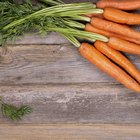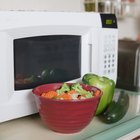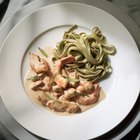zlyka2008/iStock/GettyImages
Freezing meats and vegetables is a convenient way to preserve their fresh flavor for later use, thought it does impose a degree of planning on your meal preparations. Forgetting to thaw a crucial ingredient can be seriously inconvenient, and failing to use a thawed ingredient can be wasteful. However, if you've thawed your vegetables safely and carefully, they can often be re-frozen for another occasion.
Safe Thawing
If you want to keep the option of re-freezing your unused vegetables, the first step is thawing them properly. The only way to ensure they thaw completely without ever reaching an unsafe temperature is to do it overnight in your refrigerator. A properly-running fridge keeps foods at or below 40 degrees Fahrenheit, the cut-off for the food safety "danger zone." It's possible to safely thaw your vegetables in the microwave or under cold running water, but they'll need to be used right away and shouldn't be re-frozen.
Safe Handling
Ensuring that your vegetables remain food safe while they're thawed is also important. Perishable foods should never be out of the fridge for longer than two hours in total, so leave your vegetables in the refrigerator unless you're actively cooking with them. Keep your hands, utensils and work surfaces scrupulously clean, washing them regularly with hot, soapy water. Never use the same utensils or cutting board for meats and then vegetables, especially if the meats are raw.
Re-Freezing
Return your unused vegetables to the fridge as quickly as you can and package them for re-freezing at your earliest opportunity. Use small, flat containers or bags, which will freeze more quickly than large packages. Bags or plastic wrap should be heavy-duty to minimize the risk of freezer burn and lost quality. Vacuum food sealers are the best because they remove almost all air from the packaging. That helps improve your storage life.
A Few Tips
Freezing vegetables causes the water in their cells to change into ice crystals, which expand and rupture the cell walls. This causes a loss of texture and quality every time you thaw and re-freeze a vegetable. They'll remain food safe if you follow good food-handling procedure, but it's better to package them in single-meal portions to avoid having to re-freeze an unused quantity. Blanch and freeze homegrown vegetables in small bags or containers, and divide large bags of store-bought frozen vegetables into smaller quantities. This results in faster freezing, which minimizes the size of the ice crystals and reduces the loss of quality when they're thawed.
Related Articles
How to Thaw, Cook & Refreeze Vegetables

Which Vegetables Can Be Frozen?

Leaving Cooked Vegetables Unrefrigerated
How Long After the Expiration Date Can ...

How to Preserve Rutabagas

Is It Safe to Cook Vegetables in ...

Guidelines For Refreezing

What Is the Fastest Way I Can Defrost ...

How to Freeze Carrots & Turnips
Can You Freeze Shish Kabobs?
Can I Freeze Cubed Root Vegetables?

How to Freeze Broccoli

How to Dehydrate Vegetable Chips

If I Puree Raw Vegetables Will That ...

How to Cook Vegetables in the Microwave

How to Freeze Mangetout Vegetables

Can You Refreeze Shrimp That Has Been ...

How to Freeze Chunks of Butternut Squash
Can You Thaw & Refreeze Clams?

Rules for Thawing and Refreezing Meat
References
- On Food and Cooking: The Science and Lore of the Kitchen; Harold McGee
- USDA Food Safety and Inspection Service: The Big Thaw -- Safe Defrosting Methods -- for Consumers
Writer Bio
Fred Decker is a trained chef and prolific freelance writer. In previous careers, he sold insurance and mutual funds, and was a longtime retailer. He was educated at Memorial University of Newfoundland and the Northern Alberta Institute of Technology. His articles have appeared on numerous home and garden sites including GoneOutdoors, TheNest and eHow.